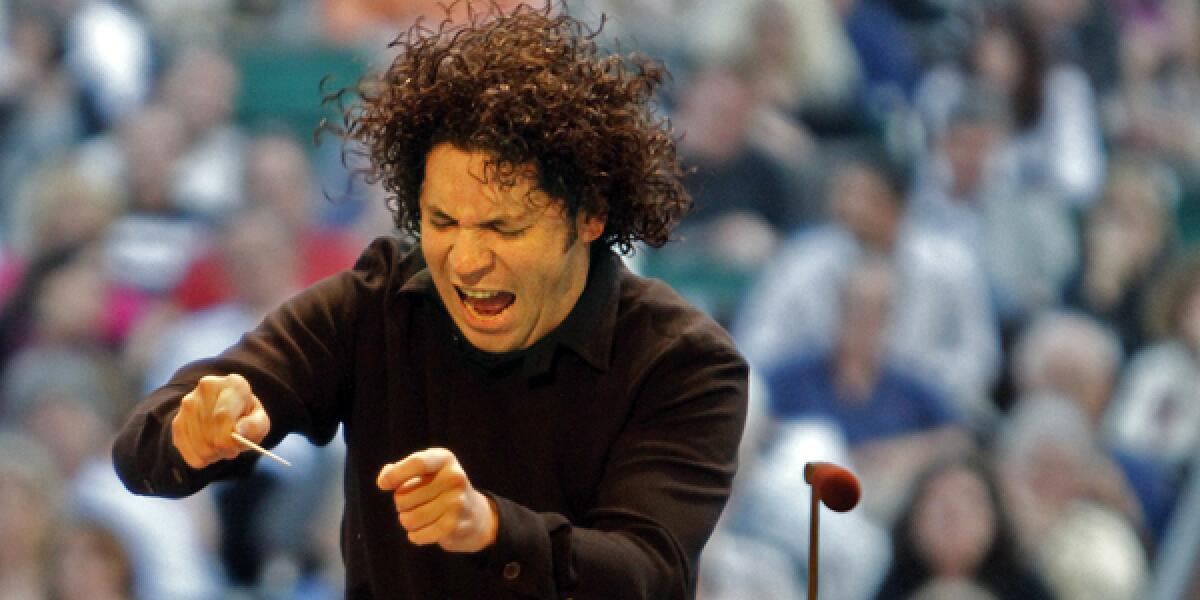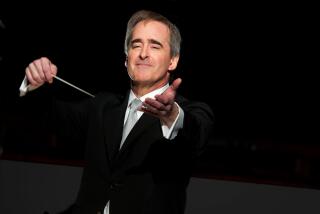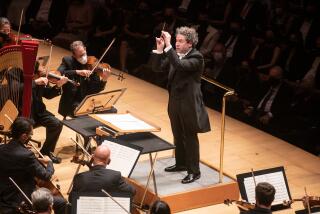L.A. Phil to transmit performances to HD-equipped movie theaters

In a bold venture that the Los Angeles Philharmonic hopes will boost its “national brand” recognition and help raise the profile of classical music from Manhattan to Orange County, the orchestra next year will transmit live performances of three of its concerts to more than 450 high-definition-equipped movie theaters throughout the United States and Canada.
Under the new project, announced Monday, the Philharmonic will partner under an exclusive one-year contract with Denver-based NCM Fathom, the entertainment division of National CineMedia, and Cineplex Entertainment, which distribute scores of concerts, sporting contests and other entertainment events to movie theaters and other venues. Among their offerings is “Met Live in HD,” the Metropolitan Opera of New York’s season of big-screen simulcasts, which have drawn more than 2.4 million people since 2006.
Deborah Borda, the orchestra’s president and chief executive, said the project, called “LA Phil Live,” would be a “major step in establishing a national brand for the Los Angeles Philharmonic and Gustavo Dudamel,” the orchestra’s charismatic 29-year-old Venezuelan music director. But she acknowledged that the orchestra faces an inherently greater challenge than an opera company in making its productions visually — as well as aurally — compelling.
“In opera they have wigs and makeup and horses parading on the stage,” she said. “But what convinced me is the vibrancy of the interaction, between Gustavo Dudamel and the Los Angeles Philharmonic and between Gustavo Dudamel and audiences. And also the setting of Walt Disney Concert Hall, because it is a unique place, a unique hall, that has a special beauty and magic that I think enhances the whole experience.”
Dan Diamond, vice president of NCM Fathom, said his organization held conversations with orchestras around the world before deciding to partner with the Philharmonic.
“The Los Angeles Philharmonic stepped up in an enormous way,” Diamond said. “We really felt that there was no one else at this point in time that had so many factors in line with what we’re doing.”
Much like a simulcast of a rock concert or a boxing match, the orchestra’s concerts will be heavily produced affairs, shot with multiple cameras and overseen by directors who specialize in live production. Viewers seated before 50-foot screens will see close-ups, medium and long-range shots of Dudamel and the orchestra’s musicians, views of Disney Hall and the audience, as well as glimpses of the backstage action. Live interviews, and question and answer sessions will round out the transmission package.
Dudamel will conduct all three simulcasts, starting with a Jan. 9 program that will include works by Beethoven, Leonard Bernstein and John Adams. The other two performances will be a March 13 all-Tchaikovsky program and a June 5 Brahms concert.
Among the Southern California movie houses that will host the transmissions are cinemas in Burbank, Palmdale, Century City and Huntington Beach. Nationally, the concerts will be seen live in more than 130 markets, including major cities with their own orchestras such as New York, Chicago and St. Louis, and smaller ones like Shreveport, La.; Greenville, S.C.; and Wilkes-Barre, Pa. Ticket prices will vary from $18 to $22 nationwide, depending on the location.
Although Borda declined to state a precise dollar figure for the Philharmonic’s investment, she acknowledged “there’s a lot riding” on the project.
Shana Mathur, the Philharmonic’s vice president of marketing and communications, said that the orchestra this week will send hundreds of letters to music organizations, music educators and other cultural entities to test the waters for prospective ticket buyers. The Philharmonic also plans to contact regional press and radio outlets and certain communities, such as senior citizens’ living centers.
“Our targets are first and foremost classical music enthusiasts or aspiring classical music enthusiasts,” Mathur said.
The Philharmonic is not the first major symphony orchestra to seek a wider audience through simulcasts. The Berlin Philharmonic broadcast its opening-night concert this fall; it also sells subscriptions to Internet streams of its concerts.
The Philadelphia Orchestra this season began distributing simulcasts of it concerts through an arrangement with Specticast, a private digital broadcast company, and Bryn Mawr Film Institute.
In a phone interview, Peter Gelb, general manager of the Metropolitan Opera, said that the Philharmonic “will have to work harder” than an opera company might to achieve a compelling visual presentation. He also cited the Met’s decades-long series of radio broadcasts in helping to build a substantial national and even international audience for its simulcasts — something the Philharmonic cannot claim.
Gelb predicted that the Philharmonic “will push the envelope” with its new series. “If they are seizing on an opportunity that others are not going after, they certainly have a chance of achieving success,” he said.
Borda said the Philharmonic will be taking measures to try to assure other symphony orchestras that its transmissions will be a beneficial addition, rather than a competitor, in their own markets. Among those gestures, she said, would be offering local symphonies the opportunity to buy blocks of seats for Philharmonic simulcasts, and offering them a space within movie theaters to promote their own orchestras.
But, acknowledging that the Philharmonic had treated its new project as “a top secret plan” to guard it from potential competitors, Borda said that the Philharmonic “wanted to be the orchestral pioneers of this.”
“To be a pioneer involves risk, and it involves a positive vision for an outcome,” she said. “And it also involves getting there first.”
More to Read
The biggest entertainment stories
Get our big stories about Hollywood, film, television, music, arts, culture and more right in your inbox as soon as they publish.
You may occasionally receive promotional content from the Los Angeles Times.







